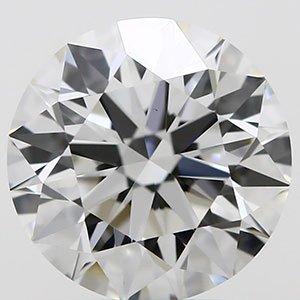What Diamond Clarity Should I Choose
Clarity refers to the diamond’s purity. All natural diamonds show traces of their growth history, which are minor internal characteristics. The clarity grading scale reflects the size, number, contrast, and location of these inclusions when examined with a 10x loupe. Below we will show you seven diamonds under a loupe to help you understand clarity. Let’s begin with the rarest diamond clarity grade.
IF (Internally Flawless) / LC (Loupe Clean)
This means that the diamond is free from anything impeding the vision of the person grading the stone, hence the term, flawless.

VVS1 (Very, Very Slightly Included)
Do you see anything in this diamond? Probably not, but expert graders of diamonds see the smallest spot under the microscope which means that this diamond is almost flawless.

VVS2
The small spot in the center of the diamond is what makes the grade of this diamond just one small step from the previous, making this diamond quite nearly flawless, but not quite.

VS1 (Very Slightly Included)
The small spot in the center of the diamond may accompany other inclusions invisible to the naked eye; yet, they give the expert eye a reason for the grade given.

VS2
Under the 10x magnification, you can probably start to see the presence of more spots within the diamond. The presences of these inclusions are mostly away from the center of the diamond and this is what justifies the VS2 grade.

SI1 (Slightly Included)
More of the spots are present towards the center of this diamond and although not obvious, they are noticeably and the grader sees them easily with magnification.

SI2
The spots in this diamond occur more frequently than the past diamonds that you’ve been looking at. The presence of these frequent spots gives a sign to the grader that this diamond is an SI2 grade.

How Does the Clarity Affect the Price of a Diamond?
The answer to this question is easily explained, rarity. The higher the clarity of a diamond, the more rare the diamond is, and in turn, the more rare, the higher the price.
Does Better Clarity Mean Sacrificing Colour or Weight?
All 4 C’s of diamonds are important factors and it’s important to decide what is most important to you. Often, when buying a diamond, there is a budget and each of the 4 C’s must be studied in order to adjust the diamond to the budget in order to decide if one or more of the C’s is more important than the others.
For more insight on the subject, read our complementary articles on carat, cut and colour.
What Are Inclusions in Diamonds?
Inclusions or spots in diamonds are like birthmarks; they show what a diamond has been through when it was growing. Just as you have scars or freckles, diamonds often show you a little bit of their past and where they came from.
Advice From Beldiamond
Most diamonds aren’t perfect, but they can look like it when they aren’t under a microscope. We always advise our clients to buy diamonds with a clarity between VVS2 and SI2. Your diamond doesn’t necessarily has to be flawless, but it’s important that we can’t see the inclusion with the naked eye.
Make sure you invest in a diamond that will make you fall in love all over again.
Take a look at our high-quality diamond engagement rings and find the right one for you.
For more inspiration, explore some of our other articles:
• The 7 Most Popular Diamond Shapes
• Lab grown Diamonds vs. Natural Ones: Which One Should You Choose?
• Why You Should Buy a Certified Diamond
The Ultimate Guide to Choosing the Perfect Engagement Ring
Thinking about proposing or choosing an engagement ring? Our free ebook is your perfect starting point—it guides you through everything from diamond selection and ring styles to sizing tips and custom design, all in a beautifully simple format.
 Natural diamond
Natural diamond
 Lab-grown diamond
Lab-grown diamond

 Diamond wedding rings
Diamond wedding rings
 Plain wedding bands
Plain wedding bands
 Natural diamond Jewellery
Natural diamond Jewellery
 Lab-grown diamond Jewellery
Lab-grown diamond Jewellery




 Tailor-made
Tailor-made
 Our Story
Our Story
 Lifetime Warranty
Lifetime Warranty
 FAQ
FAQ
 Contact Us
Contact Us
 Reviews
Reviews
 Antwerp
Antwerp
 Brussels
Brussels